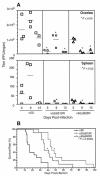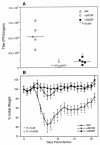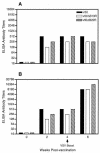Induction of potent humoral and cell-mediated immune responses by attenuated vaccinia virus vectors with deleted serpin genes
- PMID: 14990697
- PMCID: PMC353749
- DOI: 10.1128/jvi.78.6.2770-2779.2004
Induction of potent humoral and cell-mediated immune responses by attenuated vaccinia virus vectors with deleted serpin genes
Abstract
Vaccinia virus (VV) has been effectively utilized as a live vaccine against smallpox as well as a vector for vaccine development and immunotherapy. Increasingly there is a need for a new generation of highly attenuated and efficacious VV vaccines, especially in light of the AIDS pandemic and the threat of global bioterrorism. We therefore developed recombinant VV (rVV) vaccines that are significantly attenuated and yet elicit potent humoral and cell-mediated immune responses. B13R (SPI-2) and B22R (SPI-1) are two VV immunomodulating genes with sequence homology to serine protease inhibitors (serpins) that possess antiapoptotic and anti-inflammatory properties. We constructed and characterized rVVs that have the B13R or B22R gene insertionally inactivated (vDeltaB13R and vDeltaB22R) and coexpress the vesicular stomatitis virus glycoprotein (v50DeltaB13R and v50DeltaB22R). Virulence studies with immunocompromised BALB/cBy nude mice indicated that B13R or B22R gene deletion decreases viral replication and significantly extends time of survival. Viral pathogenesis studies in immunocompetent CB6F(1) mice further demonstrated that B13R or B22R gene inactivation diminishes VV virulence, as measured by decreased levels of weight loss and limited viral spread. Finally, rVVs with B13R and B22R deleted elicited potent humoral, T-helper, and cytotoxic T-cell immune responses, revealing that the observed attenuation did not reduce immunogenicity. Therefore, inactivation of immunomodulating genes such as B13R or B22R represents a general method for enhancing the safety of rVV vaccines while maintaining a high level of immunogenicity. Such rVVs could serve as effective vectors for vaccine development and immunotherapy.
Figures








Similar articles
-
Vaccinia viruses with a serpin gene deletion and expressing IFN-gamma induce potent immune responses without detectable replication in vivo.Proc Natl Acad Sci U S A. 2005 Feb 22;102(8):2940-5. doi: 10.1073/pnas.0409846102. Epub 2005 Feb 10. Proc Natl Acad Sci U S A. 2005. PMID: 15705716 Free PMC article.
-
Vaccinia virus serpins B13R (SPI-2) and B22R (SPI-1) encode M(r) 38.5 and 40K, intracellular polypeptides that do not affect virus virulence in a murine intranasal model.Virology. 1995 Jan 10;206(1):136-47. doi: 10.1016/s0042-6822(95)80028-x. Virology. 1995. PMID: 7831769
-
Vaccinia virus serpins B13R and B22R do not inhibit antigen presentation to class I-restricted cytotoxic T lymphocytes.J Gen Virol. 1995 Sep;76 ( Pt 9):2393-8. doi: 10.1099/0022-1317-76-9-2393. J Gen Virol. 1995. PMID: 7561783
-
Development of safe and efficacious viral vaccines for animals.Crit Rev Immunol. 2010;30(3):223-37. doi: 10.1615/critrevimmunol.v30.i3.10. Crit Rev Immunol. 2010. PMID: 20370631 Review.
-
Roles of vaccinia virus in the development of new vaccines.Vaccine. 1988 Apr;6(2):161-3. doi: 10.1016/s0264-410x(88)80021-5. Vaccine. 1988. PMID: 3291453 Review.
Cited by
-
Poxvirus Host Range Genes and Virus-Host Spectrum: A Critical Review.Viruses. 2017 Nov 7;9(11):331. doi: 10.3390/v9110331. Viruses. 2017. PMID: 29112165 Free PMC article. Review.
-
Poxvirus tropism.Nat Rev Microbiol. 2005 Mar;3(3):201-13. doi: 10.1038/nrmicro1099. Nat Rev Microbiol. 2005. PMID: 15738948 Free PMC article. Review.
-
Hazard Characterization of Modified Vaccinia Virus Ankara Vector: What Are the Knowledge Gaps?Viruses. 2017 Oct 29;9(11):318. doi: 10.3390/v9110318. Viruses. 2017. PMID: 29109380 Free PMC article. Review.
-
Harnessing Attenuation-Related Mutations of Viral Genomes: Development of a Serological Assay to Differentiate between Capripoxvirus-Infected and -Vaccinated Animals.Viruses. 2023 Nov 25;15(12):2318. doi: 10.3390/v15122318. Viruses. 2023. PMID: 38140559 Free PMC article.
-
Introduction of the six major genomic deletions of modified vaccinia virus Ankara (MVA) into the parental vaccinia virus is not sufficient to reproduce an MVA-like phenotype in cell culture and in mice.J Virol. 2010 Oct;84(19):9907-19. doi: 10.1128/JVI.00756-10. Epub 2010 Jul 28. J Virol. 2010. PMID: 20668072 Free PMC article.
References
-
- Amara, R. R., F. Villinger, S. I. Staprans, J. D. Altman, D. C. Montefiori, N. L. Kozyr, Y. Xu, L. S. Wyatt, P. L. Earl, J. G. Herndon, H. M. McClure, B. Moss, and H. L. Robinson. 2002. Different patterns of immune responses but similar control of a simian-human immunodeficiency virus 89.6P mucosal challenge by modified vaccinia virus Ankara (MVA) and DNA/MVA vaccines. J. Virol. 76:7625-7631. - PMC - PubMed
-
- Andrew, M. E., B. E. Coupar, and D. B. Boyle. 1989. Humoral and cell-mediated immune responses to recombinant vaccinia viruses in mice. Immunol. Cell Biol. 67:331-337. - PubMed
-
- Arita, I., and F. Fenner. 1985. Complications of smallpox vaccination, p. 49-60. In G. V. Quinnan, Jr. (ed.), Vaccinia viruses as vectors for vaccine antigens: proceedings of the Workshop on Vaccinia Viruses as Vectors for Vaccine Antigens. Elsevier, New York, N.Y.
-
- Baxby, D. 1991. Safety of recombinant vaccinia vaccines. Lancet 337:913. - PubMed
Publication types
MeSH terms
Substances
Grants and funding
LinkOut - more resources
Full Text Sources
Other Literature Sources
Miscellaneous

